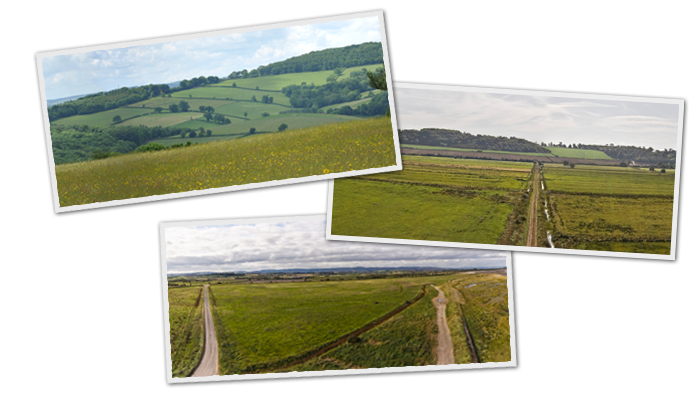
Future Landscapes
How might the Somerset landscape look in the future?
Here you can see how different rural landscapes in the Somerset WAVE area might look in the future – in the year 2060 - as the landscape and the people who manage the land adapt and respond to the effects of climate change.
The way that the landscape looks and functions depends on many environmental, economic, and social factors, all of which will be influenced by climate change effects. Our research has suggested that key drivers of rural landscape change in Somerset are likely to be the agricultural and environmental policies and regulations of any future government and the European Union.
To help illustrate this, we have developed three future scenarios for the year 2060:
- An agricultural focus – where rural land use across the area is driven by agricultural and food security policies, together with market and economic conditions that favour the maintenance of a high level of agricultural production - More...
This scenario requires the Somerset landscape to be intensively managed to control water - ensuring that the land is protected from extensive and/or prolonged flooding from the rivers or sea and wetter land is drained, while drier areas may require supplementary irrigation to the growing crops during very dry years. This scenario requires a commitment to continuing investment in and maintenance of flood defences and water management systems. New crops are likely to be exploited and animal welfare issues will become increasingly important in the hotter drier summers of 2060. Production is likely to favour larger scale agricultural enterprises, serving local, regional and national markets to match the level of investment required to maintain production.
- A biodiversity focus – Rural land use and land management is actively encouraged to maximise biodiversity interest. This would involve reduced expenditure on flood defence and water management in the area - More...
Biodiversity interests would take priority over agricultural production . However in many places the two can continue to function together, though food production is likely to be small scale, probably for more local markets. This scenario requires recognition of the value of biodiversity to society, as land managers in the area will need to be supported to actively create, restore, enhance and maintain biodiversity, traditional landscape features and the local economy.
- A multi-functional focus – where the rural landscape is managed to provide a balanced range of services to society, including food, energy, environmental, recreational and amenity - More...
In this vision the biodiversity and agricultural interests have become more balanced; different areas are designated for either biodiversity, agricultural or landscape interests. This scenario requires a balanced policy and investment strategy, with market conditions that reward small and medium scale food production, but also allow land to be used for other purposes. It is likely to be accompanied by a more regionally focused approach to encourage local residents and visitors to experience and enjoy the countryside.
The three scenarios have been applied to three typical Somerset landscapes – upland, lowland levels, and lowland coastal – taking into account the projected climate change that will take place by 2060.



